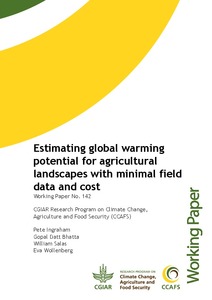Estimating global warming potential for agricultural landscapes with minimal field data and cost
 Greenhouse gas (GHG) emissions from agriculture comprise 10-12% of anthropocentric global emissions; and 76% of the agricultural emissions are generated in the developing world. Landscape GHG accounting is an effective way to efficiently develop baseline emissions and appropriate mitigation approaches. In a 9,736-hectare case study area dominated by rice and wheat in the Karnal district of Haryana state, India, the authors used a low-cost landscape agricultural GHG accounting method with limited fieldwork, remote sensing, and biogeochemical modeling. Used the DeNitrification-DeComposition (DNDC) model software to simulate crop growth and carbon and nitrogen cycling to estimate net GHG emissions, with information based on the mapping of cropping patterns over time using multiresolution and multi-temporal optical remote sensing imagery. Estimated a mean net emission of 78,620 tCO2e/yr (tons of carbon dioxide equivalents per year) with a 95% confidence interval of 51,212-106,028 tCO2e/yr based on uncertainties in our crop mapping and soil data. A modeling sensitivity analysis showed soil clay fraction, soil organic carbon fraction, soil density, and nitrogen amendments to be among the most sensitive factors, and therefore critical to capture in field surveys.
Greenhouse gas (GHG) emissions from agriculture comprise 10-12% of anthropocentric global emissions; and 76% of the agricultural emissions are generated in the developing world. Landscape GHG accounting is an effective way to efficiently develop baseline emissions and appropriate mitigation approaches. In a 9,736-hectare case study area dominated by rice and wheat in the Karnal district of Haryana state, India, the authors used a low-cost landscape agricultural GHG accounting method with limited fieldwork, remote sensing, and biogeochemical modeling. Used the DeNitrification-DeComposition (DNDC) model software to simulate crop growth and carbon and nitrogen cycling to estimate net GHG emissions, with information based on the mapping of cropping patterns over time using multiresolution and multi-temporal optical remote sensing imagery. Estimated a mean net emission of 78,620 tCO2e/yr (tons of carbon dioxide equivalents per year) with a 95% confidence interval of 51,212-106,028 tCO2e/yr based on uncertainties in our crop mapping and soil data. A modeling sensitivity analysis showed soil clay fraction, soil organic carbon fraction, soil density, and nitrogen amendments to be among the most sensitive factors, and therefore critical to capture in field surveys.
